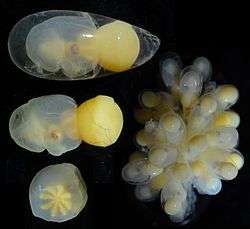Seven-arm octopus
The seven-arm octopus (Haliphron atlanticus) is one of the two largest known species of octopus; based on scientific records, it has a maximum estimated total length of 3.5 m (11 ft) and mass of 75 kg (165 lb).[3][4] The only other similarly large extant species is the giant Pacific octopus, Enteroctopus dofleini.
| Seven-armed octopus | |
|---|---|
.jpg) | |
| Ventral view of young female (70 mm ML) | |
 | |
| Lateral view of young male | |
| Scientific classification | |
| Kingdom: | Animalia |
| Phylum: | Mollusca |
| Class: | Cephalopoda |
| Order: | Octopoda |
| Family: | Alloposidae Verrill, 1881 |
| Genus: | Haliphron Steenstrup, 1861 |
| Species: | H. atlanticus |
| Binomial name | |
| Haliphron atlanticus Steenstrup, 1861[2] | |
| Synonyms | |
The genera Alloposina Grimpe, 1922, Alloposus Verrill, 1880 and Heptopus Joubin, 1929 are junior synonyms of Haliphron, a monotypic genus in the monotypic family Alloposidae, part of the superfamily Argonautoidea in the suborder Incirrata of the order Octopoda.[2]
Description

The seven-arm octopus is so named because in males, the hectocotylus (a specially modified arm used in egg fertilization) is coiled in a sac beneath the right eye. Due to this species' thick, gelatinous tissue, the arm is easily overlooked, giving the appearance of just seven arms. However, like other octopuses, it actually has eight.
Distribution
The type specimen of H. atlanticus was collected in the Atlantic Ocean at 38°N 34°W (west of the Azores). It is deposited at the University of Copenhagen Zoological Museum.[5]
Since then, several specimens have been caught throughout the Atlantic, as far as the Azores archipelago[6] and near South Georgia Island.[7]
In 2002, a single specimen of giant proportions was caught by fishermen trawling at a depth of 920 m off the eastern Chatham Rise, New Zealand. This specimen, the largest of this species and of all octopuses, was the first validated record of Haliphron from the South Pacific. It had a mantle length of 0.69 m (2.3 ft), a total length of 2.90 m (9.5 ft), and a weight of 61.0 kg (134.5 lb), although it was incomplete.[3][4]
Ecology
Isotopic,[7] photographic and video evidence[6] have shown complex interactions between H. atlanticus and jellyfish and other gelatinous zooplankton, from feeding to protection, respectively.
Predators of H. atlanticus include the blue shark, Hawaiian monk seal, sperm whale, and swordfish.[8][9][10][11][12]
Beak morphology
.jpg)
.jpg)
See also
References
- Allcock, L. (2014). "Haliphron atlanticus". IUCN Red List of Threatened Species. 2014: e.T163207A983527. doi:10.2305/IUCN.UK.2014-3.RLTS.T163207A983527.en. Downloaded on 05 February 2018.
- Julian Finn (2017). "Haliphron Steenstrup, 1859". World Register of Marine Species. Flanders Marine Institute. Retrieved 5 February 2018.
- O'Shea, S. (2002). "Haliphron atlanticus — a giant gelatinous octopus" (PDF). Biodiversity Update. 5: 1.
- O'Shea, S. (2004). "The giant octopus Haliphron atlanticus (Mollusca : Octopoda) in New Zealand waters". New Zealand Journal of Zoology. 31 (1): 7–13. doi:10.1080/03014223.2004.9518353.
- Current Classification of Recent Cephalopoda
- Rosa, R.; Kelly, J.; Lopes, V.; Paula, J.; Goncalves, J.; Calado, R.; Norman, M.; Barreiros, J. (2017). "Deep-sea seven-arm octopus hijacks jellyfish in shallow waters". Marine Biodiversity. 49: 495–499. doi:10.1007/s12526-017-0767-3.
- Guerreiro, M.; Phillips, R.; Cherel, Y.; Ceia, F.; Alvito, P.; Rosa, R.; Xavier, J. (2015). "Habitat and trophic ecology of Southern Ocean cephalopods from stable isotope analyses" (PDF). Marine Ecology Progress Series. 530: 119–134. Bibcode:2015MEPS..530..119G. doi:10.3354/meps11266.
- Henderson, A. C.; Flannery, K.; Dunne, J. (May 2001). "Observations on the biology and ecology of the blue shark in the North-east Atlantic". Journal of Fish Biology. 58 (5): 1347–1358. doi:10.1111/j.1095-8649.2001.tb02291.x.
- Goodman-Lowe, G. D. (29 October 1998). "Diet of the Hawaiian monk seal (Monachus schauinslandi) from the Northwestern Hawaiian islands during 1991 to 1994". Marine Biology. 132 (3): 535–546. doi:10.1007/s002270050419.
- Chua, Marcus A.H.; Lane, David J.W.; Ooi, Seng Keat; Tay, Serene H.X.; Kubodera, Tsunemi (5 April 2019). "Diet and mitochondrial DNA haplotype of a sperm whale (Physeter macrocephalus) found dead off Jurong Island, Singapore". PeerJ. 7: e6705. doi:10.7717/peerj.6705. PMC 6452849. PMID 30984481.
- Clarke, M.R.; Pascoe, P.L. (11 May 2009). "Cephalopod Species in the Diet of a Sperm Whale (Physeter Catodon) Stranded at Penzance, Cornwall". Journal of the Marine Biological Association of the United Kingdom. 77 (4): 1255. doi:10.1017/S0025315400038819.
- Chancollon, Odile; Pusineri, Claire; Ridoux, Vincent (1 September 2006). "Food and feeding ecology of Northeast Atlantic swordfish ( Xiphias gladius ) off the Bay of Biscay". ICES Journal of Marine Science. 63 (6): 1075–1085. doi:10.1016/j.icesjms.2006.03.013.
Further reading
- Bakken, T. & T. Holthe 2002. Haliphron atlanticum (Cephalopoda, Alloposidae) caught in Skorafjorden (64°N), Norway. Fauna norv. 22: 37-38.
- Willassen, E (1986). "Haliphron atlanticus Steenstrup (Cephalopoda: Octopoda) from the coast of Norway". Sarsia. 71: 35–40. doi:10.1080/00364827.1986.10419671.
